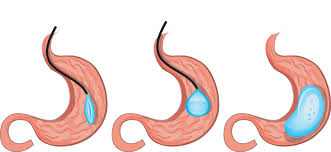
Balloon
Inserting a balloon into your stomach is a weight loss procedure that involves inserting a silicone balloon full of salt into your stomach. This will help you lose weight by limiting the amount of food you eat and feeling full faster. You need to make healthy and permanent changes to your diet and exercise regularly to ensure the long-term success of the procedure. The gastric balloon is an alternative to bariatric surgery for people with lower body mass index.
Reason to use a balloon
Inserting a balloon into your stomach will help you lose weight. Losing weight can reduce the risk of potentially serious weight-related health problems, such as:
• Gastric reflux disease (GERD)
• Heart disease or stroke
• High-blood pressure
• Obstructive sleep apnea
• Non-alcoholic fatty liver disease (NAFLD) or non-alcoholic steatohepatitis (NASH)
• Type 2 diabetes
Suitable people for balloon use
Your body mass index (BMI) is between 30 and 40
You want to commit to a healthy lifestyle change
You have never had gastric or esophageal surgery
Obalone, the newest type of balloon treatment
The balloon is the latest FDA-approved gastric balloon. There are two main differences with other gastric balloons.
How to lose weight with the help of balloon therapy
The gastric balloon helps in 2 ways to lose weight.
1. They reduce the space in your stomach for food.
2. The most important advantage may be that the balloon restricts the free passage of food and water.
Benefits of balloon therapy
• No surgery required.
• Installing it is quick and easy.
• This causes weight loss.
• When used in conjunction with a diet and exercise program, it can lead to long-term weight loss.
• You can expect to lose between 9 to 22 pounds, depending on your weight and lifestyle changes.
• You may feel full faster and less hungry when the balloon is ready.
Disadvantages of balloon treatment
• Acid reflux
• Nausea and vomiting are very common during the first few days.
• Vomiting after eating is uncommon in the first few weeks.
• Stomach cramps
• Sleep problem
• Acute beck pancreatitis is a rare risk of an overfilled saline balloon.
Prepare before placing the balloon in the stomach
You may need to do various laboratory tests before the operation. You will be asked not to drink anything for six hours before the appointment and not to eat for twelve hours before the operation. This procedure takes about 20 minutes. Your surgeon may also prescribe acid reflux and anti-nausea medication after your surgery.
After placing the balloon in the stomach
You can have a small amount of clear fluid from about six hours after the operation. The liquid diet generally lasts until the beginning of the second week, after which you can start eating soft foods. You can probably start eating regularly about three weeks after putting the balloon in your stomach.
After removing the balloon from the stomach
After six months, the balloon is removed endoscopically. At that time, a new balloon may or may not be placed.
Recovery and life with a balloon
Immediately after inserting the balloon, you will feel discomfort, which may take days to weeks. During the first week after surgery, most patients are not hungry. Your appetite may start to return slowly during week2. However, you should feel full after the minimum amount of food.
Life after the stomach balloon
Successful patients focus on the following after the balloon is removed:
Eat slowly.
Plan your meals.
Choose nutrient-rich foods.
Eliminate fast food and fizzy drinks.
Continue a consistent exercise program.




